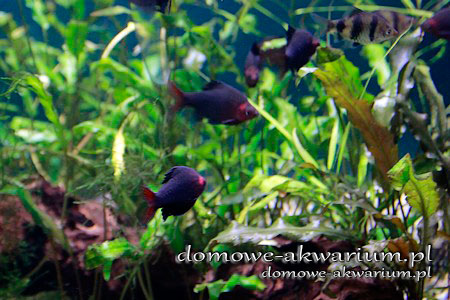
| Gatunek | Black Ruby Barb |
|---|---|
| Nazywany też | Purple-Headed Barb |
| Nazwa łacińska | Pethia Nigrofasciata |
| Rodzina | cyprinids |
| Występowanie | Azja Południowa |
| Długość | 5 - 6 cm |
| Temperatura | 22 - 26°C |
| Twardość wody | soft - medium hard |
| pH | 6.0 - 7.0 |
| Zbiornik | 80 L |
| Pokarm | live, frozen, dry, plant |
Black Ruby Barb, Purple-Headed Barb, Black Ruby Fish, Black Ruby, Ruby Barb
A freshwater species, endemic to the streams and tributaries of the Kelani and Nilwala rivers in Sri Lanka. These are forested stretches, with clear, shallow, slow-flowing water with a sandy-gravel bottom covered with litter (branches and leaves falling from trees).
The purple barbel is characterized by a laterally flattened body. The coloring of the male and female is distinctly different. The male is characterized by a graphite body color with a red head (as he ages, his colors darken even more). The fins are dark except for the tail fin, which is red. The female's body is gold-silver with three dark, transverse stripes. The fins are transparent-black. Additionally, the female is slightly larger than the male.

This is a peaceful, curious, and active fish that lives in groups. The company of 8-10 fish will make them less skittish, the males will beautifully color and compete for the females' favors. This species can be kept with practically all fish of a similar size and temperament: livebearers, loaches, catfish, corydoras, labyrinth fish, small rainbowfish, and other barbels, tetras, neons, rasboras, etc., shrimps. The slender barbel is a species that can be successfully bred by beginner aquarists.
The aquarium should be heavily planted, with free spaces for free swimming. Decorative elements can be roots. The substrate should be fine (sand or fine gravel), preferably dark. We can place a few dried oak or beech leaves on the bottom, which we replace every few weeks. Diffuse and not too intense lighting - floating plants or pieces of wood floating on the surface of the water are a good solution.

Oviparous species. It should be reproduced in a separate, poorly lit aquarium, with small-leaved plants, slightly acidic water, medium hard, with a temperature from the upper range of the scale. In the evening, we introduce one or two pairs of fish into such a prepared tank (males in the spawning period are colored with an intense red color). The fish should start spawning the next day, in the morning hours. After intensive pursuit, the female lays eggs (over 100) in batches, which fall to the bottom or stick to the plants. Parents do not take care of the roe, they can even eat it. Therefore, we should catch them without delay as soon as we notice the laid eggs. Larvae hatch after 1-2 days, after another day fry swim freely in search of food.